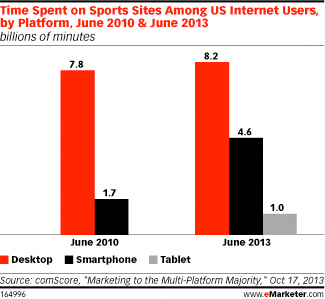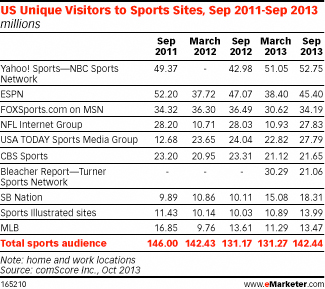The Long Road to Streaming Sports Content
November 21, 2013
![]() Like other forms of entertainment, sports programming is shifting to the digital space. US sports leagues and broadcasters are streaming increasing amounts of content on their broadband and mobile channels, and consumers are responding by tuning in on multiple screens, according to a new eMarketer report, “Sports Video Streaming: More Like a Marathon than a Sprint.”
Like other forms of entertainment, sports programming is shifting to the digital space. US sports leagues and broadcasters are streaming increasing amounts of content on their broadband and mobile channels, and consumers are responding by tuning in on multiple screens, according to a new eMarketer report, “Sports Video Streaming: More Like a Marathon than a Sprint.”
 However, in comparison with other visual media, such as full-length TV programming and short-form professional clips, most US sports content is priced above what all but the most fervent fans are willing to pay for. Further, many sports streams are inaccessible in teams’ home markets, which is where most of their fans live. And streams are often blocked for viewers who happen to get their cable, satellite or internet service from nonparticipating providers. The result is a mixed bag of programming and a series of obstacles that many sports fans simply choose to avoid.
However, in comparison with other visual media, such as full-length TV programming and short-form professional clips, most US sports content is priced above what all but the most fervent fans are willing to pay for. Further, many sports streams are inaccessible in teams’ home markets, which is where most of their fans live. And streams are often blocked for viewers who happen to get their cable, satellite or internet service from nonparticipating providers. The result is a mixed bag of programming and a series of obstacles that many sports fans simply choose to avoid.
 From an advertising standpoint, the picture is also mixed. On one hand, many brands that actively support sports broadcasts on linear TV are extending their participation to the digital space. On the other, the amount of ad revenue generated by broadband and mobile is a fraction of the billions of dollars that flow to traditional channels, and digital streams are rife with unsold inventory. It is not uncommon for a live game stream to recycle the same ads over and over, resulting in a poor experience for both brands and consumers.
From an advertising standpoint, the picture is also mixed. On one hand, many brands that actively support sports broadcasts on linear TV are extending their participation to the digital space. On the other, the amount of ad revenue generated by broadband and mobile is a fraction of the billions of dollars that flow to traditional channels, and digital streams are rife with unsold inventory. It is not uncommon for a live game stream to recycle the same ads over and over, resulting in a poor experience for both brands and consumers.
comScore’s ranking of top sports sites by monthly unique visitors over a two-year period showed Yahoo! Sports in the lead, with 52.75 million unique visitors in September 2013. Other top properties included ESPN, FOX Sports, NFL and USA Today.
The sports streaming panorama is likely to improve as more content owners and broadcasters move to fill consumer demand for instant access on multiple screens. But lucrative, long-term contracts between leagues and broadcasters will act as a counterforce to progress on the digital front. As long as the lion’s share of ad revenue comes from traditional media, the migration to digital will feel more like a marathon than a sprint.
Courtesy of eMarketer





























